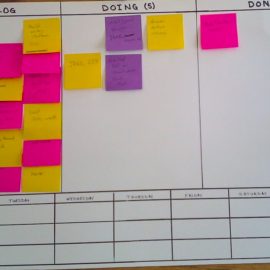

This article is an excerpt from the Shortform book guide to "The 33 Strategies of War" by Robert Greene. Shortform has the world's best summaries and analyses of books you should be reading.
Like this article? Sign up for a free trial here .
Do you know how to get success in life? What strategies of war could you use to compete and win?
Robert Greene asserts that life is a war between you and the forces or entities that seek to control you, hold you back, or destroy you. To be successful—whether in the military, business, or even your personal life—you need to win the war, and to win the war you need winning strategies.
Keep reading for details on five of these strategies.
How to Get Success in Life
To help you win your battles, Greene presents strategic insights based on his synthesis of military history, historic writings on strategy, and business dealings. Consider these strategies for how to get success in life.
Strategy #1: Understand Why You’re Fighting
It’s hard to fight a war if you don’t know what you’re fighting for. As Greene explains, the starting point for any strategy should be to identify your desired end state: What exactly are you trying to gain by fighting? Your end goal should be ambitious enough that you find it inspiring, but also small enough that you can realistically achieve it.
(Shortform note: Understanding your end goal can help you succeed in any area of life, not just business or military strategy. In The Seven Habits of Highly Effective People, Stephen Covey advises you to imagine yourself at the end of your life or career, taking stock of your impact or accomplishments. What kind of legacy do you want to be able to look back on?)
Strategy #2: Identify Your Enemies to Create Polarity
Once you understand your end goal, you need a clear picture of who or what stands between you and that goal—in other words, your enemies. Greene says that clearly identifying your enemies is not just a prerequisite for developing a plan to defeat them: It will also give you a better understanding of what you stand for. This is because the conflict will highlight the contrast between you and your enemy, making your key differences more visible.
Strategy #3: Use the Power of Knowledge
Once you know what you want to achieve and what enemies stand in your way, you can begin planning your war. To do this, Greene recommends that you immerse yourself in the best available information on the environment in which you’ll be fighting, the condition of your own forces, and the enemies that you must overcome. Try to anticipate how your enemies will act and react to each of your moves. Consider different ways things could turn out, and make detailed plans for how you would respond to each possible situation.
Greene advocates this method of creating detailed plans branching into many alternative scenarios because it allows you to adapt quickly to changing conditions. Plans that depend on a rigid schedule quickly fall apart because things never turn out exactly according to plan.
| Strategizing With Limited Information In Crossing the Chasm, Geoffrey Moore applies a similar principle to the business problem of choosing the best market segment to target with a new product. His analysis highlights a nuance of the principle: Even after studying the best information that you have, you’ll still have to make decisions based on limited information because there will always be unknown factors. This is certainly true in military campaigns, and equally true when you’re introducing a new product, because you can’t collect statistics on customers that you don’t have yet. Moore’s solution to this problem is to create customer characterizations, or descriptions of a hypothetical customer, complete with information about their age, job, goals, and so on. These descriptions should be as realistic and as lifelike as possible. Once you’ve created profiles for the archetypical customers that might want your product, you use them to think through hypothetical purchasing scenarios: What does the customer’s current situation look like without your product? How would having your product solve her current problems? Is the improvement enough to compel her to buy? By anticipating how each hypothetical customer would behave in each scenario, you can assess which customer would be most likely to buy your product. Then you target the market segment where the customers of that archetype are most concentrated. Like Greene, Moore also recommends making your strategy flexible: As new information about customer preferences or purchasing habits becomes available, you can use it to update your scenarios and, if necessary, pivot your marketing campaign. According to Moore, the reason this method works is that your intuition is much better at predicting how a person would respond to a situation than it is at predicting the behavior of abstract entities like markets. And you’ll ultimately have to choose a market based on informed intuition since you don’t have enough data to make an analytical decision. |
Strategy #4: Don’t Let Emotions Cloud Your Judgment
As Greene points out, having a flexible plan with detailed options that you thought through in advance can help you avoid making irrational decisions when you’re under stress or under the influence of strong emotion.
A common theme that Greene discusses in many strategies, but especially in planning, is the importance of managing strong emotions. He warns that, in most circumstances, humans are more emotional than rational. For example, when you face setbacks and heavy opposition, you’ll likely feel discouraged and be tempted to quit too early. In the face of vicious attacks, you may feel angry and vengeful toward your enemy, making it tempting to retaliate in ways that hurt them even if it also hurts your own cause. And the exhilaration of victory might make you feel invincible, tempting you to launch new attacks that may not be prudent.
| How Do Strong Emotions Cloud Your Judgment? Other authors provide additional insight on why strong emotions sometimes provoke irrational decisions and how planning can help. For example, in Emotional Intelligence, Daniel Goleman explains that your emotions arise from the interaction of two parts of your brain: the amygdala and the prefrontal cortex. The amygdala analyzes input from your senses and generates emotional alerts. The prefrontal cortex analyzes emotional signals from the amygdala and sends feedback signals to the amygdala. For example, suppose you’re walking through your garden and glimpse a rubber hose that looks vaguely like a poisonous snake. Your amygdala recognizes a possible threat and sends a fear signal to the rest of your brain. Then your prefrontal cortex identifies it as a false alarm (because it recognizes the object as a hose, not a snake) and cancels the fear signal. Your prefrontal cortex performs other functions as well. It holds the ideas that you’re currently thinking about, called your “working memory,” and it participates in rational analysis. However, if the amygdala is sending out strong emotion signals (for example, because you’re in a dangerous situation), your prefrontal cortex can get overloaded to the point where it can’t perform these other functions, or at least can’t perform them as well. This is why strong emotions can degrade your analytical reasoning capabilities. But having a plan that you’ve reasoned through ahead of time can save you from having to rely on your compromised reasoning faculties when you’re under emotional stress. |
Strategy #5: Keep Your Enemies Guessing
The better you can predict what your enemies will do, the more easily you can develop a strategy to defeat them. But the better your enemies can anticipate what you will do, the more effectively they’ll counter it. Thus, a key element of any strategy is to prevent your enemies from figuring out what you’re up to until it’s too late. Greene discusses several ways to achieve this.
(Shortform note: Sometimes just having a proactive strategy is enough to catch your opponents off-guard. In Good Strategy Bad Strategy, Richard Rumelt observes that most people and organizations don’t have a defined strategy—instead, they just react to circumstances. And they tend to assume that everyone else does the same, so they won’t expect you to plan ahead.)
Keep Your Options Open
Greene advises you to keep your options open. The more actions you can take, the harder it is for someone to anticipate what you will do.
As a way to increase the flexibility of your forces, he suggests splitting up your army into small teams that can function autonomously but can also join forces to fight larger battles. Additionally, this increases the number of separate forces that your enemy has to try to keep track of, which compounds the difficulty of predicting your moves or inferring your overall strategy.
| Keep Your Options Open in the Battle for Financial Freedom Greene presents the strategy of splitting your force into autonomous teams in the context of military operations, but you can apply an analogous principle to other parts of life, such as personal finance. Think of it this way: Your enemy is poverty. Its attacks come in the form of bills, expenses, and other financial setbacks. Your income is the army you use to defeat those attacks, and each of your independent revenue streams is like an autonomous combat team. If your sole source of income is your day job, this is like having your whole army fighting as one unit: Your options are limited, and if you lose your job, you’ll be at the mercy of your expenses. But if you got an additional part-time job it would increase your options and reduce your risk. If you also invest in stocks, the returns provide another independent source of income. Maybe you also publish a book, create an app, or start a YouTube channel about one of your hobbies. These create additional revenue streams, further increasing your options. Together, these diverse revenue streams create a strong financial army. |
Stay Ahead With Bold and Unconventional Maneuvers
When you launch an offensive, Greene recommends that you keep your forces moving fast enough that your enemy doesn’t have time to react. By the time they figure out how to counter your first move, you’ll be well into your second or third, making their response irrelevant.
He also suggests that you occasionally make a move that looks so bold, audacious, or unconventional that it seems almost insane. If your enemies mistakenly assume that you wouldn’t do anything imprudent, they’ll interpret your audacious moves as a sign of greater power than you actually have. Having miscalculated your strength, they won’t be able to predict your moves as easily. If they don’t make that mistake, it will still make you harder to read, because an irrational opponent is, by definition, unpredictable.
| Make Your Competitors Irrelevant Before They Catch On Greene recommends advancing quickly and boldly, even audaciously, to keep ahead of your enemies. Analogous business strategies include blitzscaling, where you grow your company so fast your competitors can’t catch up, and having a blue ocean strategy, where you boldly go where your competitors have never gone. The premise of blitzscaling is that the key to making certain products successful is to grow your user base as quickly as possible. This works best with digital products that have negligible marginal cost (once you’ve created the product, making additional copies doesn’t cost you anything) and significant network effects (the more people use the product, the more useful it becomes, like social media apps). Meanwhile, the premise of a blue ocean strategy is to offer a product that provides unique value to your customers. If your product is truly unique, then by definition, there won’t be any direct competition, giving you space to build up a profitable market. Furthermore, when you introduce a product that’s fundamentally different from the competing products of other industry players, those players initially tend to think you’re crazy and dismiss your product as something nobody would want. By the time they realize that your product has opened up a whole new profitable market, it may be too late for them to compete effectively with you because market leadership tends to be self-perpetuating. (Once your brand has a reputation for being the best in its class, it’s easier to make sales and attract top talent, which helps you continue to make the best products.) Blitzscaling goes hand in hand with a blue ocean strategy, because it only works in newly opened markets, where you can be the first to secure a majority of the market. When you use a blue ocean strategy, you create a new market where your competitors didn’t see one, which initially confuses them. And if you grow rapidly to dominate the market, the network effect makes your product so much more valuable than any competing alternatives that they’ll never catch up with you, even when they catch on to the new market. This illustrates Greene’s principle that making unprecedented moves and building on them quickly gives you an advantage over your opponents. |

———End of Preview———
Like what you just read? Read the rest of the world's best book summary and analysis of Robert Greene's "The 33 Strategies of War" at Shortform .
Here's what you'll find in our full The 33 Strategies of War summary :
- How to win the war between you and those that seek to control you
- Insights based on military history, historic writings, and modern-day business dealings
- Why the little guy may actually have the biggest advantage






